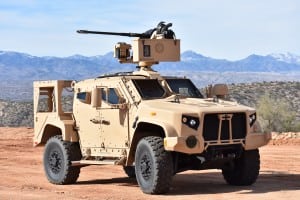Kongsberg recently detailed the latest plans for its remote weapon station, on platforms such as the Army’s Joint Light Tactical Vehicles, including starting production on the updated version of the capability by the end of the year and gauging interest in a smaller, lighter iteration geared toward the Special Operations community.
Jason Toepfer, the company’s business development and marketing director, told Defense Daily
that ‘Tech Refresh’ effort will look to produce new Common Remote Weapon Stations (CROWS) with improved thermal sight capabilities and a new “architecture backbone.”

“Tech Refresh is essentially the next generation for CROWS as the current provision program of record. It began as an obsolescence improvement program, but it brought so much improvement capability that it eventually became billed as an overall technological improvement,” Toepfer said. “Even if we account for any kind of holdup as a result of COVID-19, we’re still generally on track to begin production activities on Tech Refresh by the end of the calendar year.”
The upgrades with the CROWS Tech Refresh include utilizing Leonardo DRS’ TS3 thermal sight tool and Kongsberg’s own Integrated Combat solution “architecture backbone.”
“The inherent architecture in Tech Refresh will allow for target sharing, essentially tasking targets from one remote weapon station to another and also passing targets to other Kongsberg systems like our medium-caliber turret that also has that same architecture,” Toepfer said.
Kongsberg has also built a small number of prototypes for the CROWS Light that the company plans to offer for Special Operations or logistics vehicles, according to Toepfer.
“That’s a significantly lighter, smaller remote weapon system that allows for applications that require a smaller, lighter system, whether it’s logistics vehicles or Special Operations applications. The chassis itself is lighter. It is able to accept either a .50 caliber machine gun or one of the new 338 Machine Guns, the Special Operations munitions standards that’s emerging now,” Toepfer said. “For CROWS-L it’s a system that we’ve executed as an [independent research and] development because we’ve received enough feedback from the Special Operations community that there’s an interest in having a smaller, lighter remote weapon station.”
Toepfer noted the company is also continuing to refine the lightweight 30mm Remote Weapon Station that it demonstrated on a JLTV last summer.
“We’re continuing to improve and refine the lightweight 30mm-configuration that we showed at the [Javelin missile] demonstration at Redstone Arsenal last summer. We’re continuing to improve the supply line and refining the mechanics of that system,” Toepfer said.
Oshkosh Defense [OSK], which manufactures the JLTV, demonstrated the Javelin capability on the platform last June following the Army’s decision to approve the program for full-rate production (Defense Daily, June 24).
At the now-canceled AUSA Global Force Symposium in Huntsville, Alabama, slated for earlier this month, Oshkosh had planned to display a JLTV outfitted with the Kongsberg lightweight 30mm Remote Weapon Station and for the first time with a side-mount Stinger missile launcher.